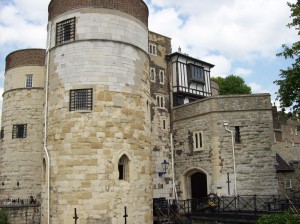
At dawn on 2nd May 1536, Sir Henry Norris, Henry VIII’s Groom of the Stool and great friend, was taken to the Tower of London. He had been held at York Place overnight after being interrogated by the King, but “would confess nothing to the King.”1
Mark Smeaton had also been taken to the Tower, and the imperial ambassador, Eustace Chapuys, wrote to Charles V on 2nd May telling him that George Boleyn, Lord Rochford, had been taken to the Tower around lunchtime. George had been arrested at Whitehall, not Greenwich, suggesting that he had an inkling that all was not well and was on his way to see the King. Interestingly, Las nuevas de Ynglaterra de la presion de la Manceba del Rey reported that Rochford was “imprisoned for not giving information of her crime”2 so it may be that the incest charge was ‘cooked up’ later.
Meanwhile, Anne Boleyn was watching a game of real tennis at Greenwich when she was disturbed by a messenger telling her that the King had ordered her to present herself to his privy council. Anne left the tennis match and presented herself in the council chamber in front of a royal commission consisting of the Duke of Norfolk (her uncle), Sir William Fitzwilliam and Sir William Paulet. There she was informed that she was being accused of committing adultery with three different men and that Smeaton and Norris had confessed. Anne was then taken to her apartments until the tide of the Thames turned and then, at two o’clock in the afternoon, she was escorted by barge to the Tower of London.
Anne entered the Tower by the Court Gate of the Byward Tower, not Traitors’ Gate, where she was met by Sir Edward Walsingham, the Lieutenant of the Tower. Walsingham escorted her to the Royal Palace, where Sir William Kingston, the Constable of the Tower, was waiting for her. Kingston recorded what happened at their meeting in a letter to Thomas Cromwell:
“On my lord of Norfolk and the King’s Council departing from the Tower, I went before the Queen into her lodging. She said unto me, ‘Mr. Kingston, shall I go into a dungeon?’ I said, ‘No, Madam. You shall go into the lodging you lay in at your coronation.’ ‘It is too good for me, she said; Jesu have mercy on me;’ and kneeled down, weeping a good pace, and in the same sorrow fell into a great laughing, as she has done many times since.
She desired me to move the King’s highness that she might have the sacrament in the closet by her chamber, that she might pray for mercy, for I am as clear from the company of man as for sin as I am clear from you, and am the King’s true wedded wife. And then she said, Mr. Kingston, do you know where for I am here? and I said, Nay. And then she asked me, When saw you the King? and I said I saw him not since I saw [him in] the Tiltyard. And then, Mr. K., I pray you to tell me where my Lord my father is? And I told her I saw him afore dinner in the Court. O where is my sweet brother? I said I left him at York Place; and so I did.
I hear say, said she, that I should be accused with three men; and I can say no more but nay, without I should open my body. And there with opened her gown. O, Norris, hast thou accused me? Thou are in the Tower with me, and thou and I shall die together; and, Mark, thou art here to. O, my mother, thou wilt die with sorrow; and much lamented my lady of Worcester, for by cause that her child did not stir in her body. And my wife said, what should be the cause? And she said, for the sorrow she took for me. And then she said, Mr. Kyngston, shall I die without justice? And I said, the poorest subject the Kyng hath, hath justice. And there with she laughed.”3
How ironic that Anne was imprisoned in the Queen’s Lodgings of the Royal Palace, the same apartments that Henry VIII had had refurbished for her coronation in 1533.
While Anne, Smeaton, Norris and Rochford were being imprisoned in the Tower, Henry VIII was meeting with his illegitimate son, Henry Fitzroy, Duke of Richmond. Chapuys recorded their meeting, writing that the King broke down in tears and told Richmond “that both he and his sister, meaning the Princess, ought to thank God for having escaped from the hands of that woman[Anne Boleyn], who had planned their death by poison”.4 Chapuys went on to say that from the King’s words he could conclude “the King knew something of her wicked intentions.” Was it bluster and crocodile tears or did Henry VIII really believe that Anne had been planning to kill Richmond and Mary?
Here is the arrest scene from The Tudors series. It contains a few inaccuracies (e.g. Anne was not sewing, Brereton did not confess and had not been arrested yet) but I find the interaction between Anne and Kingston very moving.
Notes and Sources
- From “A Memorial from George Constantyne to Thomas Lord Cromwell” which can be read in Anne Boleyn: In Her Own Words & the Words of Those Who Knew Her by Elizabeth Norton, p205
- LP x.784
- LP x.793
- Calendar of State Papers, Spain, Vol 5 Part 2:1536-1538, 55